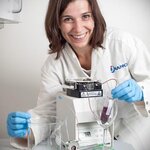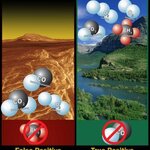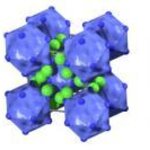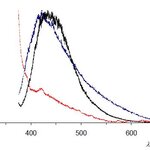Chemistry

Wine, with its thousands of chemical combinations, can be hard to judge. As numerous studies have shown, getting experts to distinguish between a $4 bottle of wine and a $40 one is in the luck range
Can a nanosensor do better? Researchers at Aarhus University believe they are on that path, at least when it comes to dryness.
When wine growers turn their grapes into wine, they need to control a number of processes to bring out the desired flavor in the product that ends up in the wine bottle. An important part of the taste is known in wine terminology as astringency, and it is…

Molecules containing carbon-halogen bonds are produced naturally across all kingdoms of life and constitute a large family of natural products with a broad range of biological activities.
The presence of halogen substituents in many bioactive compounds has a profound influence on their molecular properties and a goal of chemical science has been to find the late-stage, site-specific incorporation of a halogen atom into a complex natural product by replacing an sp³ C-H bond (one of the most inert chemical bonds known in an organic compound) with a C-X bond (X=halogen).
There has been no…

Astronomers searching the atmospheres of alien planets for gases that might be produced by life, such as oxygen, ozone, or methane, may be missing the mark - because those gases can be produced non-biologically.
Methane is a carbon atom bound to four hydrogen atoms. On Earth, much of it is produced biologically - burping cows are a classic example - but it can also be made inorganically; for example, volcanoes at the bottom of the ocean can release the gas after it is produced by reactions of rocks with seawater.
Ozone and oxygen were previously thought to be stronger…

Image credit: Pslawinski via Wikimedia | http://bit.ly/1lzJKDE
By Chris Gorski, Inside Science
(Inside Science) -- Xenon is one of the so-called noble gases. It's odorless, colorless and a loner. It very rarely combines with other atoms, or even itself, to form molecules. Like helium, neon, argon, krypton and radon, it's kind of a wallflower that rests on the far right of the periodic table.
Unlike most of those others, though, recent reports show that xenon might improve athletic performance in endurance sports. The gas may also help erase traumatic memories.
The element also has a number of…

In 1929 Linus Pauling came up with Pauling's Rules to describe the principles governing the structure of complex ionic crystals.
These rules essentially describe how the arrangement of atoms in a crystal is critically dependent on the size of the atoms, their charge and type of bonding.
According to scientists from the Biohybrid Materials Group of Aalto University Finland led by Mauri Kostiainen, similar rules can be applied to prepare ionic colloidal crystals consisting of oppositely charged proteins and virus particles. The results can be applied for example in packing and protecting…

A certain type of biomolecule, called a glycoconjugate, is built like a nano-Christmas tree. Its many branches are bedecked with sugary ornaments that get all the glory. That's because, according to conventional wisdom, the glycoconjugate's lowly "tree" basically holds the sugars in place as they do the important work of reacting with other molecules.
A chemist at Michigan Technological University has discovered that the tree itself — the scaffold — is a good deal more than a simple prop.
The discovery opens up new avenues for research, in particular the development of more and…

The first direct observations of how facets form and develop on platinum nanocubes reveals that a nearly 150 year-old scientific law describing crystal growth breaks down at the nanoscale.
The researchers behind a new study used transmission electron microscopes and an advanced high-resolution, fast-detection camera to capture the physical mechanisms that control the evolution of facets – flat faces – on the surfaces of platinum nanocubes formed in liquids.
Understanding how facets develop on a nanocrystal is critical to controlling the crystal's geometric shape, which in turn is critical to…

Researchers have developed a new process which will greatly simplify the process of sorting plastics in recycling plants by enabling automated identification of polymers and facilitating rapid separation of plastics for re-use.
The researchers, led by Professor Heinz Langhals of
Ludwig-Maximilians-Universität München's Department of Chemistry, have developed a technique which provides for automated recognition of their polymer constituents, improving the efficiency of recycling and re-use of the various types of plastic. The technique takes advantage of the polymer-specific nature of the…

Biofuels production has never lived up to the hype. It does something, so it is less hype than quantum computers have been for 15 years, but biofuels suffer from inefficiencies that have kept it from improving due to time and experience, some of which is that subsidies and mandates lead to less innovation rather than more, and then there is a chemistry problem.
There may be hope for the chemistry problem. A new paper
the Journal of the American Chemical Society finds that water in the conversion process helps form an impurity which slows down key chemical reactions.
Researchers…
There’s
an emerging trend, of late, in the seemingly endless saga of the chemical
bisphenol A (BPA),
which is most commonly used to make polycarbonate plastic and epoxy resins. Although the BPA saga has not yet become
completely passé, much of the attention that had been given to BPA is now
focused on alternatives to BPA. Indeed, it
seems that BPA-Free is becoming the new BPA.
For
what seemed an eternity, BPA had been at the center of a perfect storm
comprised of scientists, regulators, legislators, environmental activists and
the media. Their collective fascination
with BPA…